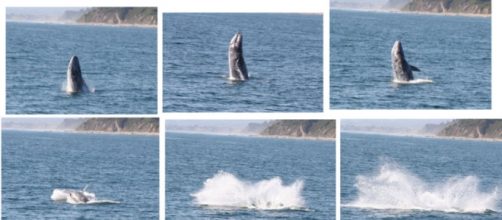Gray Whale from Genus Eschrichtius
The gray whale is a marine mammal belonging to the genus eschrichtius. This mammal migrates once a year from the cold waters in the North Pacific to the shallow and warmer waters in The Baja peninsula in Mexico. The gray whale usually stays most of the summer season feeding in the Arctic and in October, it begins a long journey, considered as the longest for any mammal, throughout the western coasts of Canada, USA and Mexico, where they remain for as long as required to mate and give birth to new baby whales.
Gray Whale physical description
These whales are not completely gray, but display a gray to dark color. Their body is covered by gray-white marks or wounds created by parasites that stick to their bodies or have evacuated from it. Tiny depressions on their upper jaw contain a sole rigid hair. Contrary to other whales with prominent channels, they only show inconspicuous ones under the throat. They have two blowholes on the top of their head and used them to produce a distinguishable V shape on the water surface.
Whale calves may be just about 5 meters (16.4 feet) long at birth, while adults may measure from 13-15 meters (43-49 feet); although, females are usually longer than males. An adult gray whale may gain a total weight of 40 tons and live from 50-70 years old.
Gray whales possess a baleen, which is like a brush which they use to filter the food that has been placed in the mouth. The baleen is located in the upper jaw. Whenever the whale swallows food from the ocean water or the sediments at the bottom of the ocean, the food (krill) is usually retained inside the mouth, while the remaining water is evacuated. This mechanism leaves only the food in the mouth.
Gray whales do not have a dorsal fin, like any other whale, instead, it has lumps in the central part of its rear quarter section, also called the dorsal ridge. They have an average tail 3-3.5 meters long, which is intensely rough at the center and thin at the edges.
Annual Migration
Gray whales begin their migration around the month of October, which is when the ice in the arctic begins to form, making them move further to the south.
This two to three month yearly displacement starts at the Bering and Chukchi seas and culminates in the shallow waters of Baja Califronia peninsula, Mexico.
Gray whales usually travel day and night, using energy reserves during the endeavor. It´s believed that they don´t travel without taking a break, and they do this by taking brief snoozes of 10-20 minutes during the trip.
They may reach speeds of 8 km/h (5 mph), while swimming, covering an average distance of around 120 km/h (74 mph). The round trip from the north pacific to Baja California, Mexico covers an approximate distance of 20,000 km (12427 miles), making it the longest migration taken by any marine mammals in the planet.By the last days of December and early January, the whales begin to arrive to the lagoons; Ojo de Libre, Magdalena and San Ignacio, where they will mate and give birth to their calves, before going back to the Arctic.
After the mating and breeding in the last days of February and April and March, the whales start migrating north of the Pacific, with the pregnant females and mothers with a calf being the first ones to depart. If a calf is not ready to take the long voyage, the mother and the calf may remain some more time in the lagoons.Female gray whales experience single ovulation; however, only few occurrences of births involving twins have been reported.
Threats to whales
Dangers to the gray whale include human activities in the open ocean and in the Mexican lagoons:hunting of gray whales, toxic wastes, and spills of oil into the ocean and entanglement into fishing equipment.Another danger that the gray whale faces is predation from Killer whales (Orcas), especially during its return to the Arctic.

